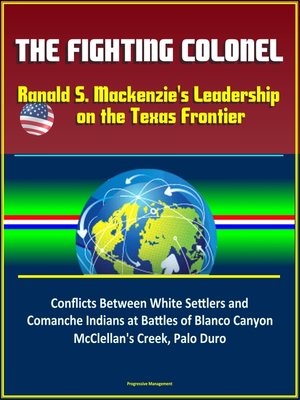The Fighting Colonel
ebook ∣ Ranald S. Mackenzie's Leadership on the Texas Frontier--Conflicts Between White Settlers and Comanche Indians at Battles of Blanco Canyon, McClellan's Creek, Palo Duro
By Progressive Management

Sign up to save your library
With an OverDrive account, you can save your favorite libraries for at-a-glance information about availability. Find out more about OverDrive accounts.
Find this title in Libby, the library reading app by OverDrive.



Search for a digital library with this title
Title found at these libraries:
| Library Name | Distance |
|---|---|
| Loading... |
This excellent report has been professionally converted for accurate flowing-text e-book format reproduction. The Texas frontier during the years following the Civil War was a dangerous place. Comanche constantly harassed and raided white settlements. Despite the efforts of President Ulysses S. Grant's Peace Policy, conflict between white settlers and Indians persisted. In February 1871, Civil War veteran Colonel Ranald S. Mackenzie, West Point Class of 1862, assumed command of the 4th US Cavalry Regiment. Throughout the next four years, he led his regiment on a series of campaigns across Texas, which effectively eliminated the Comanche as a serious threat to the frontier settlements. The Comanche, often called the "Lords of the Southern Plains," were some of the most fierce and ruthless Indians on the plains. They posed a major problem for US Army leadership. The Army needed someone who could take the fight to the enemy and establish relative peace and security.
This study examines the most significant factors of Mackenzie's leadership against the Comanche that altered the security environment of the post-Civil War Texas frontier. This study also explores Mackenzie's military tactics and characteristics of the Comanche warrior in three specific Texas battles-the Battle of Blanco Canyon (1871), the Battle of McClellan's Creek (1872), and the Battle of Palo Duro Canyon (1874). Through credible primary and secondary sources, this study demonstrates the utmost significance of Mackenzie's decisions and leadership (however imperfect), the importance of Mackenzie's soldiers and superiors, and concludes with applicable lessons for today's US Army.
The decade following the Civil War offered a new set of challenges for US Army officers and soldiers. For many officers who fought during the Civil War, the end of the war meant settling down to a nice, quiet life after years of intense, bloody fighting. For other officers, however, the post-Civil War years meant heading west to wage a different type of war against a different type of enemy. Graduating at the top of his West Point class in 1862 and once called the "most promising young officer" by General Ulysses S. Grant, Ranald Slidell Mackenzie was one of these officers.
In his book, U.S. Army Counterinsurgency and Contingency Operations Doctrine 1860-1941, Andrew J. Birtle calls the post-Civil War years "the Constabulary Years." He writes that Americans viewed their Army as the "national jack-of-all trades." In addition to their military duties, soldiers conducted other activities and assumed other roles, such as engineer, laborer, policeman, border guard, explorer, administrator, and governor. Like the most recent wars in Iraq and Afghanistan, the Indian Wars in the American West proved to be a harsh, complex environment, which required strong leadership, using a combination of conventional and unconventional tactics to accomplish the US Army's wide-ranging objectives.
White settlers in Texas throughout the mid-to-late 1800s endured Comanche raids that effectively terrorized the frontier. One raid in particular was the Warren Wagon Train Massacre on May 18, 1871 in Salt Creek Prairie, Texas. A wagon train consisting of ten wagons and 12 men were hauling supplies from Weatherford, Texas to Fort Griffin, Texas when 150 Indians attacked the wagons.







